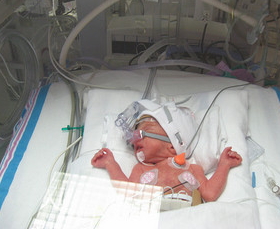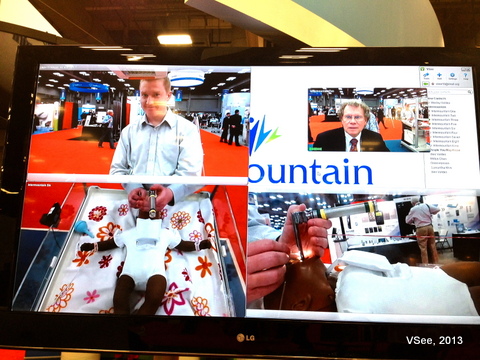 The February issue of the Pediatric Annals journal features a new study on an Intermountain teleneonatology pilot, along with several other articles focusing telemedicine. The recent pilot, conducted by expert neonatologist, Dr. Stephen Minton, Intermountain business director, Mark Allan, and Intermountain telehealth director, Dr. Wesley Valdes, shows how an Intermountain-designed teleneonatology unit is increasing family participation in the care of preemie infants in their Neonatal Intensive Care Unit (NICU) and also providing remote consultation services for neonatal resuscitation procedures.
The February issue of the Pediatric Annals journal features a new study on an Intermountain teleneonatology pilot, along with several other articles focusing telemedicine. The recent pilot, conducted by expert neonatologist, Dr. Stephen Minton, Intermountain business director, Mark Allan, and Intermountain telehealth director, Dr. Wesley Valdes, shows how an Intermountain-designed teleneonatology unit is increasing family participation in the care of preemie infants in their Neonatal Intensive Care Unit (NICU) and also providing remote consultation services for neonatal resuscitation procedures.
We invite HIMSS 2014 conference attendees to stop by Intermountain booth #3903, to get a live demonstration of Intermountain’s teleneonatology unit powered by VSee 🙂
Reference and abstract to the study below:
Teleneonatology: A Major Tool for the Future by Stephen Minton, MD; Mark Allan, MBA; Wesley Valdes, DO
Pediatric Annals, February 2014 – Volume 43 · Issue 2: e50-e55, DOI: 10.3928/00904481-20140127-1
Abstract:
Hospitals have, for centuries, maintained a central position in the health care system, providing care for critically ill patients. Despite being a cornerstone of health care delivery, we are witnessing the beginning of a major transformation in their function. There are several forces driving this transformation, including health care costs, shortage of health care professionals, volume of people with chronic diseases, consumerism, health care reform, and hospital errors.
The neonatal intensive care unit (NICU) at Utah Valley Regional Medical Center in Provo, Utah, began an aggressive redesign/quality improvement effort in 1990. It became obvious that our care processes were designed for health care deliverers and not for the families. An ongoing revamp of our care delivery processes was undertaken using significant input from a parent focus meeting, parental interviews, and development of a parent-to-parent support group.
As a result of this work, it became obvious we needed a new model to truly empower parents. The idea of “NICU is Home” was born. We elected to make a mind shift, not to focus on what families think, but rather on how they think.
Web cams and other video apparatus have been used in a number of NICUs across the country. We decided our equipment requirements would need to include high-resolution cameras, full high-definition video recording, autofocus, audio microphones, automatic noise reduction, and automatic low-light correction. Our conferencing software needed to accommodate multiple users and have multiple-picture capabilities, low bandwidth, and inexpensive technology. It was recognized that a single video camera feed was insufficient to adequately capture the desired amount of information.
Verbal communication between parents and their babies’ principal care providers is critical. Parents loved the idea of expanding the remote NICU web cam of their baby to a two-way physician-parent communication bedside monitor. Doctors at Utah Valley Regional Medical Center now have a mobile desk using a WiFi computer/camera/audio to communicate with the family in real-time or leave a recording.
 Make sure to check out the Intermountain Tele-NICU in booth #3903 at HIMSS or read about it here.
Make sure to check out the Intermountain Tele-NICU in booth #3903 at HIMSS or read about it here.
photo credit: hudsonthego via Flickr



